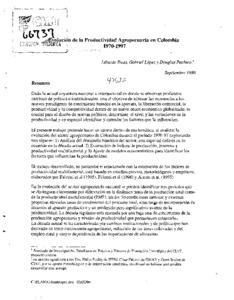Evolución de la productividad agropecuaria en Colombia 1970-1997
The evolution of Colombia`s agricultural sector is analyzed for 1970-1997 regarding three issues: (1) analysis of the sector`s historical development, with special emphasis on the 90s; (2) estimate of production indexes, inputs, and multifactorial productivity; and (3) adjustment of econometric models to identify factors influencing productivity. Three periods can be clearly differentiated in the evolution of the national agricultural sector periods based on the dynamics of total production and multifactorial productivity (MFP). During the 70s, internal and external conditions facilitated high growth rates of total product, high incorporation rates of inputs into the productive apparatus, and a moderate but significant increase in productivity. The 80s were marked by a low agricultural production growth rate and stagnant levels of productivity. The 90s were characterized by institutional and policy changes that have slowed down agricultural growth, reduced cultivated areas and rural employment, and increased dependency on imported food. During the long study period (1970-1997), few products have successfully maintained high and stable production growth rates. Among these are exportable products or products with a high local agroindustrial demand, such as flowers, oil palm, peanut, fruit trees, and banana. In most of these crops, increased production was mainly based on increase in cultivated areas. The low growth rate of production and the unemployment of production resources in Colombia`s rural sector during the 1990s can beattributed mainly to the reduced income-return. Although the economic aperture helped reduce production costs, the fall of real prices of agricultural products in domestic markets voided any positive effect on income-return. Changes in income-return restored aggregate production, and permanent or plantation crops gained importance. Overall, the performance of products related to CIAT`s international mandate (beans, rice, cassava, milk, and beef) has been acceptable in terms of productivity, especially during the 1990s, which was considered a critical time. Although productivity has had a significant effect on production growth, pertinent efforts must continue to thus increase the competitiveness of national agricultural production. The rigorous selection and prioritization of agricultural activities showing high potential in domestic and external markets, together with the development of viable and sustainable technological alternatives, are fundamental to any strategy seeking modernization of the country`s agricultural sector.

